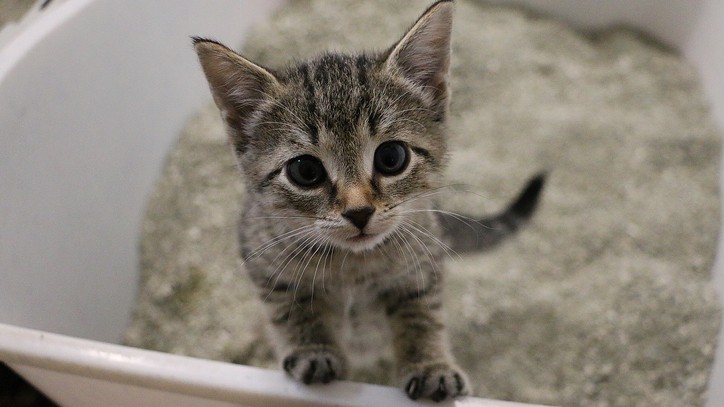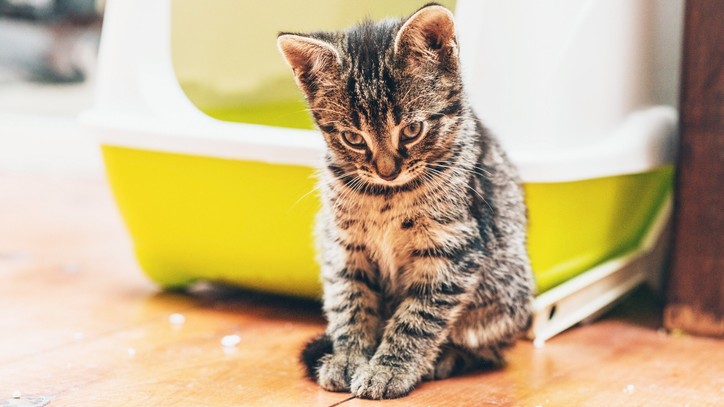Here’s how to litter train a kitten according to a vet (spoiler alert: it’s just five steps!)
Trying to figure out how to litter train a kitten? You need this vet’s simple advice.

When it comes to how to litter train a kitten, you’ll be relieved to hear that the process is relatively straight forward — which is good, because as a new pet parent you likely have a fairly long list of skills and behaviors you’re wanting to teach your little fur friend.
Learning how to potty train a kitten early on using the best cat litter box can be a real lifesaver when it comes to preventing toileting issues down the line. It also gives your kitten a designated quiet place where they can do their business and it provides you with the huge benefit of an easy clean up!
Most cats already have that instinctive desire to bury their urine and feces, so you’ll likely find your kitten masters litter box training fairly quickly. However, just like when it comes to selecting the best kitten food, it may take a small amount of trial and error to find a box and a type of litter that appeals to your kitty, so don’t be afraid to experiment.
To help you move through the training process quickly and easily, we spoke to vet Dr. Catherine Barnette to get her thoughts on how to potty train a kitten. Below, she shares her simple five-step process as well as her solutions for common litter box problems. Let’s take a look…

Dr. Catherine Barnette is a small animal veterinarian with 14 years of clinical experience in small animal general practice. She currently divides her time between part-time clinical practice and freelance writing, while also volunteering in her community. Her primary medical interests are preventive medicine and client education.
1. Gather the right supplies
There are two basic supplies that you will need to train your kitten: the best cat litter and a litter box. While these items probably seem straightforward, give some thought to your product selection.
When searching for a litter box, you will find that there are a wide variety of available in pet supply stores. Some litter boxes are enclosed, some are open with high sides to minimize spilling, and some are open with low sides. Some litter boxes scoop themselves automatically, while others require you to do the scooping. (See our roundup of the best self-cleaning cat litter boxes, if you’re a more squeamish cat owner!)
Many cats will happily use any litter box you offer, but others are more picky. To maximize your chances of success, consider purchasing two different types of litter boxes. Setting up both boxes can give your kitten the opportunity to select the type of litter box that she prefers. In general, most kittens prefer an open-top litter box with low sides, because it is easier to climb in and out of these types of boxes.
Get the best advice, tips and top tech for your beloved Pets
Cat litter, like litter boxes, is also available in a seemingly-endless number of varieties. Most cat owners use clumping clay litter, but you can also find alternatives made from pine, recycled newspaper, and other materials. Many kittens use any type of litter that they are offered, but Dr. Jacqueline Neilson, a veterinary behaviorist, states that most cats “prefer clumping litters and litters with activated carbon.”
This preference is attributed to the texture and odor control of clumping litter, combined with the odor control properties of activated carbon. Purchasing a litter with these attributes can help maximize the likelihood that your kitten readily uses the litter box.
2. Select the right litter box location
Don’t place the litter box in a noisy or unpleasant area. Ideally, the litter box should be in a quiet location, near where your kitten will spend most of her time.
A litter box that’s located far from the action, such as in a basement or out in the garage, is less likely to be used than a litter box that’s centrally-located and accessible. Although we’d all like to keep our kitten’s litter box out of sight, it’s important to think about convenience for your kitten.
Many cat owners place their litter box in the laundry room. This is often okay, but it can be problematic if your kitten is afraid of the sounds that your washing machine and dryer make while running!
3. Limit litter box competition
When it comes to how to keep the peace in a multi-cat household, you need enough litter boxes to limit competition. Having to compete with housemates or “wait in line” to use the litter box is inconvenient, increasing the likelihood that one of your cats will decide to eliminate outside of the litter box.
In general, multi-cat families should have one more litter box than they have cats. So, if you have three cats, you should have at least four litter boxes. These boxes should be evenly distributed around your home, instead of placing them all in a single room.

4. Introduce your kitten to the litter box
As soon as you bring your new kitten home, place her directly in the litter box. This will allow her to locate the box and become familiar with its appearance, smell, and location. For the first few days, take your kitten to the litter box several times per day, especially after meals and naps.
In the early days, you can also confine your kitten to a small area of your home, near the litter box. Keeping her close to the litter box will reduce the likelihood that she wanders too far from the litter box and has an accident because she can’t make it back to the box in time.
5. Keep the litter box clean
If your kitten does have an accident near or outside of the litter box, clean the area thoroughly using an enzymatic cleaner. Don’t punish your kitten for the accident. Instead, clean the area thoroughly, and ensure that the litter box and its surroundings remain clean.
Kittens prefer a clean litter box. Just like humans, cats do not want to use a dirty restroom! Keeping a litter box clean will encourage your kitten to use it, reducing the likelihood of accidents outside of the litter box.
If you use clumping litter, scoop your kitten’s litter daily. This allows you to remove urine or feces that your kitten has left in the litter box, controlling odor. When you notice the litter is losing its fresh scent, or roughly once a week, dump all of the remaining litter and scrub the litter box. Use a mild dish soap to clean the box, to avoid leaving harsh chemical odors in the box.
Check out our guide to 'do you know how (and how often) to clean litter boxes?' for more on this.
How long does it take to litter-train a kitten?
Kittens are born with a natural desire to go potty in sand or soil. Many kittens also watch their mother bury their urine and feces in the sand, further reinforcing the desire to seek out a sandy spot to eliminate. A litter box is probably the most attractive sandy surface in your home; therefore, your kitten will likely begin using the litter box as soon as they are introduced to it.
Some kittens may have occasional accidents until they become familiar with the location of the litter box. Additionally, like little kids, kittens sometimes become so distracted by play that they forget that they need to use the litter box. It may take time for your kitten to learn that they need to head to the litter box when they feel the urge to eliminate. By the time they are a few months old, though, most kittens are using their litter box reliably.
Solutions for common litter box problems

Still having trouble with litter training your kitten? These common solutions to everyday litter box problems can help put your training back on track!
1. Rule out internal parasites
Intestinal parasites can cause loose stools, which may make litter box training difficult. All kittens need regular veterinary care, including fecal parasite examinations, deworming, and vaccines, but this is especially important in kittens with litter box issues. When it comes to how to treat a kitten with worms, it's best to consult with your vet.
2. Make their litter box accessible and inviting
Next, focus on making your kitten’s litter box as inviting and accessible as possible. Some kittens get so distracted by playing that they cannot make it to the litter box when they need to go potty. Consider setting up several litter boxes around your home, so your kitten is never too far from a litter box. Alternatively, confine your kitten to a smaller area of your home that is close to the litter box.
Ensure that the litter box is inviting. Even young kittens prefer a clean litter box, so it’s important to ensure that you are scooping the litter box daily and performing a thorough cleaning (removing the litter and scrubbing the box) every week or two.
3. Try a different cat litter or litter box
Finally, try a different type of litter and/or a different style of litter box. Some cats have strong preferences for a certain type of litter or a certain style of box. Offering your cat an alternative can help you discover their preferences.
4. Talk to your veterinarian
If you are still having litter box issues after trying these tips, consult your veterinarian for more guidance.
Although kittens can tolerate a wide variety of litter box situations, it will be easier to litter train a kitten if you have a good litter box setup. The habits that your kitten develops in these early months will carry forward for the rest of her life, so it’s important to proactively work to prevent problems from an early age.
For more helpful advice to help you navigate those first few months as a pet parent, be sure to take a look at these essential kitten training tips and how to reduce cat litter smells.
Dr. Barnette is a graduate of the University of Florida, where she received both her B.S. in Zoology and her Doctor of Veterinary Medicine (DVM). She has 15 years of clinical experience as a small animal veterinarian, treating dogs, cats, and occasional exotic patients. She now works as a freelance veterinary writer, creating educational content for veterinarians, veterinary team members, and dedicated pet owners. Dr. Barnette lives in southwest Florida with her husband and daughter (plus two cats, a dog, and a rescued dove!) and enjoys kayaking, biking, and hiking. Learn more about Dr. Barnette at www.linkedin.com/in/catherinebarnette.

